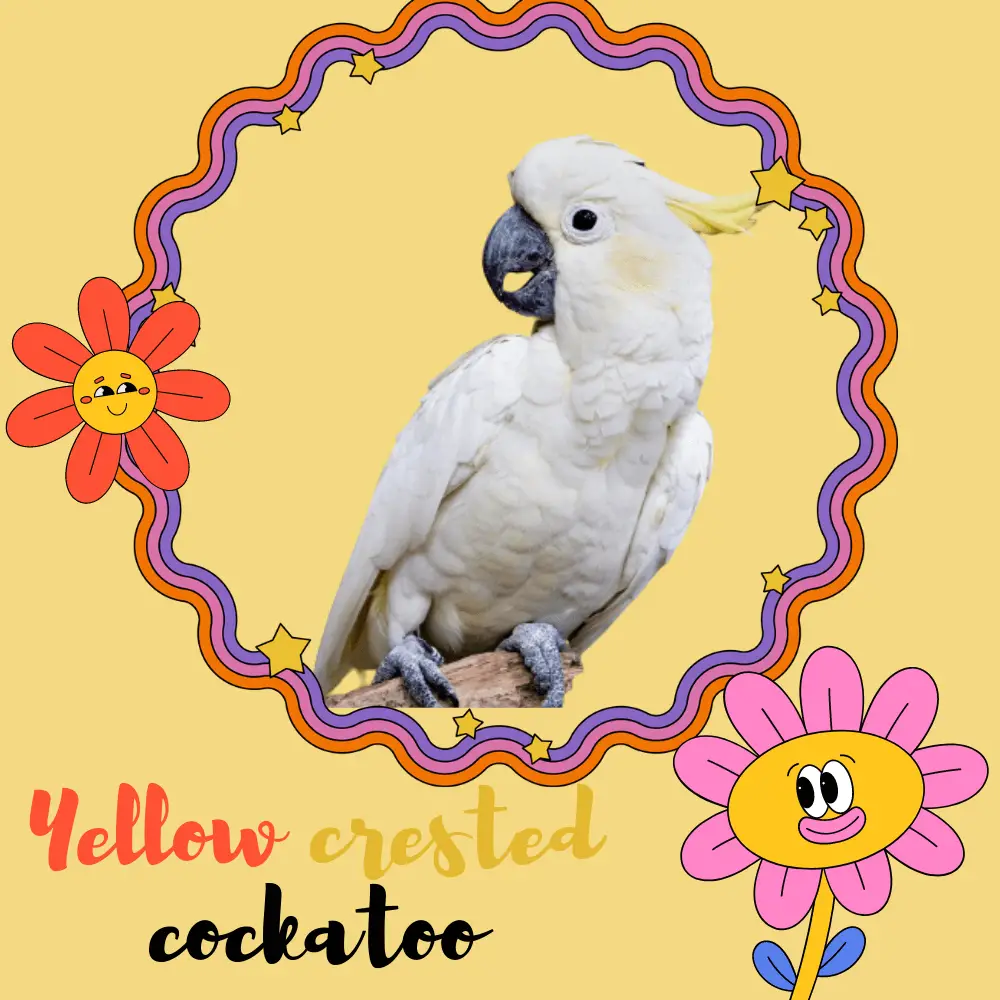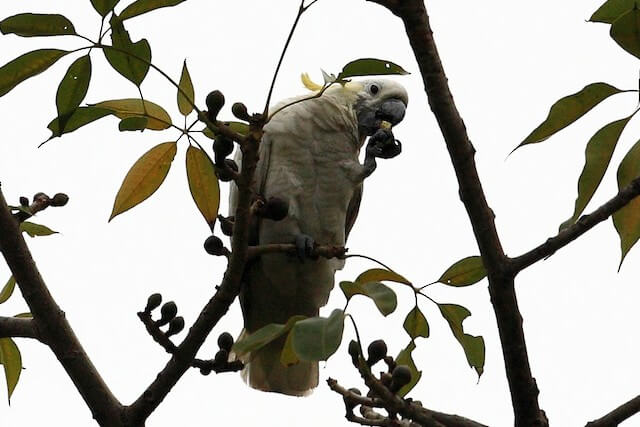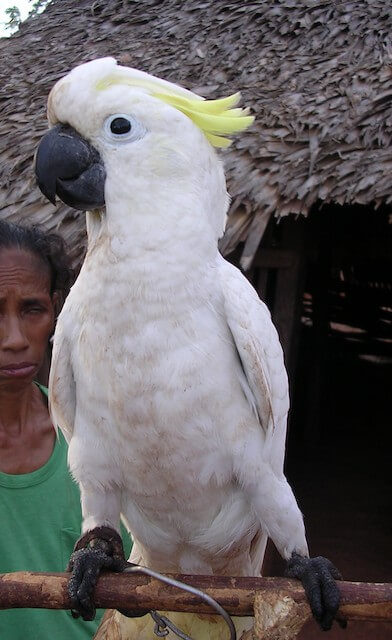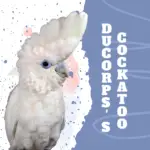
Yellow crested Cockatoo or Cacatua sulphureac. 33 cm; 350 g. with long, forward-curving yellow crest feathers, yellow ear-coverts, and yellow undersurfaces of wings and tail; bill black; feet grey; eye black in male, red-brown in female; bare periophthalmic skin pale blue.
Immature similar to adult, but iris pale grey. Races separated on size, the intensity of yellow on ear-coverts, and crest colour.
Systematics History
Editor’s Note: This article requires further editing work to merge existing content into the appropriate Subspecies sections. Please bear with us while this update takes place.
Closely related to C. galerita and C. ophthalmica. Race citrinocristata distinctive by virtue of long peachy-orange vs yellow crest ; reportedly livelier, noisier disposition ; and vs abbotti larger bill but shorter wings, vs sulphurea, djampeana and occidentalis longer tail , but vs parvula longer tail , hence scoring 7 against all taxa except 6 vs parvula .
Race abbotti strikingly large (except in bill size) , with small, pale brownish-yellow ear-covert patch . Races djampeana and occidentalis generally regarded as synonyms of nominate race and parvula, respectively, but new evaluation indicates real morphological differences and even possible subspecific division within djampeana . Six subspecies recognized.
Subspecies

Introduced (not citrinocristata) to Hong Kong and Singapore.
SUBSPECIES
Cacatua sulphurea sulphurea Scientific name definitions
Distribution
Sulawesi, Muna, Butung, Tanahjampea and adjacent islands
SUBSPECIES
Cacatua sulphurea abbotti Scientific name definitions
Distribution
Masalembu Besar I (Java Sea).
SUBSPECIES
Cacatua sulphurea parvula Scientific name definitions
Distribution
Lesser Sundas (Sumbawa to Timor)
SUBSPECIES
Cacatua sulphurea citrinocristata Scientific name definitions
C. s. citrinocristata
Distribution
Sumba (SW Lesser Sundas).
Distribution
Editor’s Note: Additional distribution information for this taxon can be found in the ‘Subspecies’ article above. In the future we will develop a range-wide distribution article.
Yellow crested cockatoo habitat
Woodland and cultivation, but not found inside forests; occurs from sea-level up to 500 m on Sulawesi, and sometimes up to 1200 m elsewhere.
Movement
Tends to roost communally and to feed in groups.
Yellow crested Cockatoo Diet

Feeds mainly in trees, taking seeds, nuts, berries and fruit. Destroys young fruits of Ceiba and Gossampinus, and attacks coconuts.
Sulphur crested cockatoo behaviour
Commonest call is a harsh grating note on an even pitch or slightly modulated, “grrreh”. When perched, vocabulary more diverse, with most notes having similar tonal quality to flight call, combined with nasal squeals and squawks.
Yellow crested cockatoo breeding
Poorly known; birds in breeding condition in Sept/Oct. Nests in tree-hollow, e.g. in Gossampinus. 2–3 eggs. Other data from captivity: incubation c. 27 days, by both parents; chick has sparse yellow down; nestling remains in the nest for c. 10 weeks, fed by both adults.
Yellow crested cockatoo lifespan
yellow crested cockatoos have a life expectancy almost equivalent to that of a human, about 80 years. It can therefore keep you company throughout your life.
Sulphur crested cockatoo as pets
Several species of parrots are called cockatoos, large parrots native to Australia, New Guinea, and Indonesia. Most of these birds are recognizable by their very lively feather crest or crest. Cockatoos form, with the cockatiel, the subfamily Cacatuinés.
The yellow crested cockatoos are good at staying active, playing and interacting well with the humans they take care of.
Very intelligent and curious, they are also particularly expressive and sometimes very noisy, both in their cries and in the human expressions they are able to repeat.
Aggressive behaviours are also observed, especially on the part of the male toward the female in the Sulphur-crested Cockatoo. Their taming and their education, therefore, require a lot of tact and patience.
SOURCE: Kevin Black
Yellow crested cockatoo conservation status
These Parrots are very long-lived and can live upwards of 75 years in captivity, although yellow crested cockatoos only live to about 20–40 years in the wild
CRITICALLY ENDANGERED. CITES I. Formerly common, but all races have been seriously reduced in numbers due to widespread trapping

for the agricultural trade, in combination with habitat destruction. Dramatic population decline, particularly in the late 20th century; now extinct on many islands and close to extinction on most others.
Whereabouts of populations large enough to supply so many birds are unknown to scientists; trapping roosting birds with sticky poles may eliminate whole populations. Race abbotti
critically endangered, with only 10 birds encountered in 2008. Probably extirpated on Lombok and close to extinction on Sulawesi, Sumbawa and Flores; 7 separate sightings of 2–19 birds in Rawa Aopo Watumohai National Park, SE Sulawesi in autumn 1995. Not recorded on Nusa Penida (E of Bali) since 1986.
Occurrence on a considerable number of islands over an extensive area may mask serious decline throughout most of the range. Still fairly common on Komodo, in the national park. Race citrinocristata
may be vulnerable, due to habitat loss and trapping, combined with expected further loss of nest-sites. Global population estimated at fewer than 7000 individuals: 3200–5000 on Sumba, 500 on Komodo despite estimated decline of 60% between 2000 and 2005
200–300 on Timor Leste, 200–300 on Sulawesi, 20–50 on West Timor, 40–70 on Flores, 50–100 on Sumbawa, 100 on Rinca and c. 700 other birds in total.
The precipitous decline is almost entirely attributable to national and international trade, but is now exacerbated by large-scale logging and habitat destruction.
Illegal trapping continues in many areas including Rawa Aopa Watumohai National Park, Buton and Kadatua Islands. Previously considered Endangered, its rapid ongoing population decline, caused by unsustainable trapping for the cagebird trade, led to its uplisting to Critically Endangered in 2000.
The significant increase recorded however in Sumba in 2002, is attributable to trade ten years before. Each subspecies should now be managed as a separate unit of conservation concern. Law enforcement must be improved.




















